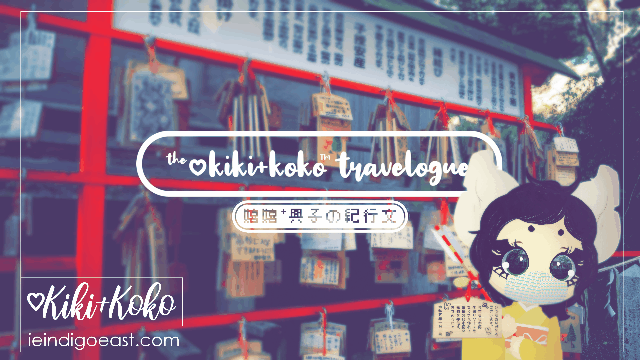 こんにちにゃあ~!Welcome to Kiki+Koko: Let’s NihonGO!! Online! Serving you the freshest blends three times a week for your discerning linguistic palates. We’re continuing with yet another delicious hiragana blend! That’s right, today’s fresh blends will be presented by our lovely assistant, QUIZBO™! This blend is from the マ行, ma-gyou, (ま row) which gives it a fun flavour that really dances on the palate. We’ve been really throwing these blends at you one after another, so be sure to pace yourself and be sure to go back often to make sure you understand and remember the previous ones! We’ll be presenting more concepts in future, but for now, it really is important to catch up a bit on reading in order to really help you in future lessons.
こんにちにゃあ~!Welcome to Kiki+Koko: Let’s NihonGO!! Online! Serving you the freshest blends three times a week for your discerning linguistic palates. We’re continuing with yet another delicious hiragana blend! That’s right, today’s fresh blends will be presented by our lovely assistant, QUIZBO™! This blend is from the マ行, ma-gyou, (ま row) which gives it a fun flavour that really dances on the palate. We’ve been really throwing these blends at you one after another, so be sure to pace yourself and be sure to go back often to make sure you understand and remember the previous ones! We’ll be presenting more concepts in future, but for now, it really is important to catch up a bit on reading in order to really help you in future lessons.
As we always want to reiterate, learning to read is an essential part of learning Japanese, a building block that sets the foundation to assist in everything from pronunciation to simply the ability to learn new vocabulary, and especially future conjugation of verbs and adjectives. (We’ve been sure to give you as much time as you need to get accustomed to the previous conjugations we’ve presented in order to allow the next ones to be less jarring.) Which brings us to another quick topic worth mentioning before we jump into the main part of the lesson. We never want to rush anyone along who needs a bit more time to learn and become accustomed to new characters, which is why we try to structure these lessons in a way that helps those who learn more quickly simply make the characters feel more second-nature whilst also allowing those who may need a bit of extra time to have plenty of opportunities to not only get accustomed to the characters, but to also find what way really works for them to help them differentiate and read as well as take in new information with ease. Because, all in all, we can give you the tools, but it’s important for you to actively know what works best for you.
If there’s a certain kind of lesson that works the best for you or some way that helps you understand and recognise a character or concept, feel free to leave a comment or contact us through our various social media or contact section! As your guides and teachers, we try to put ourselves in your shoes, seeing these from the perspective of someone who may or may not have had previous experience with Japanese language, and we never want to succumb to the ‘curse of knowledge’ which is why we put ourselves in positions to be completely new to concepts to truly understand the feeling. But, even still, your experience is unique, but no matter how unique, there could be someone on the other side of the world who thinks and learns in the same way that you do, and they could benefit greatly from your experience. So, don’t be shy! You can be anonymous, as well. Your journey can be your own, and you can keep it as a personal experience until you’re ready to practise in public, or your experience can be as public as you wish, giving accountability. But, even still, we always want to reiterate that learning isn’t a race! We know from experience that in any subject, even ‘fast learners’ can accidentally just encode facts and topics to their short term memory, just learning for the test, and then find it not as concretely in their long term memory. Except for QUIZBO™くん, but he’s a computer robot who never forgets, even if his hardware is from the Heisei era and his software is up-to-date… But we digress!
The point to take away is to be realistic, don’t rush, always revise/review to keep even what seems ‘easy’ in your memory, and just have fun and enjoy! This is a language in an entirely different language branch to your own (most likely, unless perhaps your native language is Ryukyuan or your a time traveller from the past who speaks an extinct branch like Peninsular Japonic language, in which case: Hello from the future, time traveller! And: Please go back to a different year, dear time traveller, the year this was published in is broken; have a nice day. Or, we suppose those who speak Korean natively have a much easier time transitioning to Japanese… yet, the similarities make the differences more difficult when native Japanese speakers transition to Korean… But, we digress, again!) The focus of the point is: you’re doing great! Maybe you say to yourself that ‘only‘ know a few of the characters so far, or you think you can say ‘only‘ a few sentences. But, look at it this way: you know a few characters; you can say a few sentences! You know more than you did yesterday! Or you didn’t forget what you learned and you actually properly have it in your memory, and that’s a big step. The more you know, the more your brain gets used to knowing more and can use the connections you’ve created to learn new concepts. So, one small step is actually a giant one in the course of your journey.
As we transition to the heart of the lesson, we know can’t be so naïve as to think everyone who’s visiting is completely up-to-date on lessons, to whom most of this introduction has been addressing. And, all of this talk of ‘blends’ may seem confusing, and you may be wondering where your nice cuppa tea or coffee is waiting for you. But, we have something that will last you even longer: 拗音, youon! You can find out 「拗音とは?|What is youon?」after a go at understanding 五十音順、gojuuonjun, and from there, you should take a dive into the previous blends, soaking it all up before you make your way here. This would include:「きゃきゅきょ」, 「しゃしゅしょ」、 「ちゃちゅちょ」, 「にゃ、にゅ、にょ」 , and 「ひゃひゅひょ」. After that, you should be prepared to have a sip of today’s tasty blends!
Now, we always want to emphasise as lessons continue that each of them are built atop of one another, leading you from one concept to the next to make each concept less of a leap and more of a step. If you’re attempting to learn a new language, it can be difficult enough, and we don’t want you to find yourself becoming overwhelmed. That’s why, if you haven’t already, again, we recommend that if you’re even dabbling in Japanese language, you’ll want something to guide your linguistic palate. Being presented with a smörgåsbord of various teas and coffees may leave you interested but if you’re unsure which is which, it’ll all just be a sea of hot beverages that you can’t make out. But, if you have a proper guide, you’ll immediately be able to perceive the intended flavours and minutia whilst being able to get to that higher plane of enjoyment. So, if you’re just getting started, we recommend you have a look at our super quick guide: How Do You Write in Japanese? | Japanese Writing System Demystified . It’ll give you a basic look at what you can expect out of the Japanese writing system so that you won’t just see a bunch of lines and squiggles, but different sets of writing that we’ll break down into proper digestible serving sizes for you currently and in future. It’s an important and essential skill, knowing how to read which we explain in the linked article, but one should still be familiar with romanisation spelling, which, again, we explain in the linked article, but it’s just important not to rely on it. You can, however, rely on us to assist you with these concepts and more during each lesson! We’ll take you by the digital hand and lead you down the journey towards your Japanese learning goals! The first step can be taken right here: Let’s Read HIRAGANA!! | with Kiki+Koko &QUIZBO™.
Though the second round of lessons listed are of the large version of 「やゆよ」ーnot the small version we’ll be using today, which is 「ゃゅょ」ーit’s important to go back and keep these fresh in your mind. Though it can be helpful when it comes to stroke order when characters are utilised in different ways, it can become a bit muddied when it comes to differentiating them, especially in some fonts where the small characters may not be extremely tiny. So, just be sure to use this as an opportunity to be sure you’re comfortable with the initial characters before moving onto these new blends. And, here to help us introduce you to these new blends, we should probably welcome back your computer friend and ours, QUIZBO™くん!(The ™ is silent)

Hello, there!僕、 QUIZBO™くんです!平仮名拗音を読みましょう!Let’s read hiragana youon! Let’s NihonGO!!
If you remember from previous instalments, this is a portable version, QUIZBO™ Mini, who lives here on the site. He’ll be here to help sound out these hiragana for you. You can click the sound ‘bytes’ as many times as you’d like, QUIZBO™ won’t mind. ( Get it, bytes? … Computer? ……..bytes? ………sound bites….? …..Yeah, we’ll be holding off on our stand-up careers. ) Afterwards, you’ll be able to take a quiz with QUIZBO™ to help you review them or test your knowledge!
Are you ready!?
Let’s NihonGO!! みゃみゅみょ!!
We’re going to show you the character(s), then you you can click the play button to hear QUIZBO™ sound it out for you. But, as a better visualisation of each sound, we also have the romanised pronunciation of each character so you have something in English to which you can compare it.

In romaji, 「みゃ」 is transliterated as「mya」which sounds like「myahh」.
Helpful Hints with Kiki+Koko:
Just as in the previous lesson, it’s important to remember this is one singular syllable when spoken. Rather than the incorrect ‘✖mee-yah’, it is pronounced as simply ‘〇myah’. With time, it will become easier to automatically see characters ending in a い vowel next to a tiny ヤ行, y-row, character which automatically negates the い vowel, leaving you with a proper blend.

In romaji, 「みゅ」 is transliterated as 「myu」which sounds like ‘mew’ and may be recognisable from the first half of the name of the P☆kemon known as ‘Mewtwo’
Helpful Hints with Kiki+Koko:
You can use the sound of the English word’s equivalent in order to get used to the single syllable of 拗音, youon!When many say ‘hue’, there’s no gap betwixt the ‘m’ sound and the ‘yu’ sound. So, just be sure to keep the middle 「い」sound out of the equation when you encounter it with a small 「ゃ」「ゅ」or「ょ」
(Hopefully if you’ve heard the name ‘Mewtwo’, it will assist with proper pronunciation for this one!)
 In romaji, 「みょ」 is transliterated as 「myo」which sounds sort of like 「myohh」.
In romaji, 「みょ」 is transliterated as 「myo」which sounds sort of like 「myohh」.
Helpful Hints with Kiki+Koko:
 There’s not much more we can add that we haven’t said in the previous hints, however one helpful hint is that you’ll often find this one and the one above paired with う in長音, chouon. So, it’s important to always be able to differentiate whether it’s simply みょ, romanised 「myo」, or if it’s been romanised with a long vowel as in original Hepburn with the macron above: 「myō」which can be confusing as to know whether it’s 「みょう」,「みょお」or even 「みょー」! However, you needn’t worry about that after you learn to read hiragana. Though, this does bring up 長音, chouon, which is a useful concept you can read about in our previous article: 長音とは?|What is chouon?
There’s not much more we can add that we haven’t said in the previous hints, however one helpful hint is that you’ll often find this one and the one above paired with う in長音, chouon. So, it’s important to always be able to differentiate whether it’s simply みょ, romanised 「myo」, or if it’s been romanised with a long vowel as in original Hepburn with the macron above: 「myō」which can be confusing as to know whether it’s 「みょう」,「みょお」or even 「みょー」! However, you needn’t worry about that after you learn to read hiragana. Though, this does bring up 長音, chouon, which is a useful concept you can read about in our previous article: 長音とは?|What is chouon?
And, there you have it! That was 「みゃみゅみょ」! With only a few to learn, it shouldn’t be too terribly much to practise, however that doesn’t mean you shouldn’t give it the care and attention it deserves. You’ll need to keep these concepts properly differentiated between their hiragana gojuuon counterparts as well as future 拗音, youon. But, we know that if you’ve already made it this far, your mind is already expanding to the point where we know you’ll be able to memorise these and utilise them with time! It’s all about revision, patience, and a positive attitude. Whether you study often in shorter time periods or with spaces between for longer times, it’s all about exposure. You want to keep these fresh in your mind and once they’re concrete, you’ll want to contrast them with their similar counterparts to face the difficulties head-on so that you can more easily differentiate. And, no matter what method works best for you, we’ll be there for you every step of the way, providing you with the resources you need, on your Japanese language learning journey.

Grooving to the content we’re creating? You can leave a TIP in the TIP♡JAR to keep it going!
(Can’t? No worries! The content is free for everyone! We’re just glad you’re here!! Bring friends if you like~!)
Speaking of which, we want to continue to ensure your steps to success in your Japanese language learning goals, whether you want to just learn a bit for fun or become fluent. You can ensure the continuation of the creation of new and even better content by leaving a TIP in the TIP♡JAR to keep it going. But! You can also support the content when you purchase any artwork from ieindigoeast.redbubble.com (making sure to use our special redbubble link). But, if there’s something that isn’t from our theme, you can always drop Indigo East a ‘Bubblemail’ if you want to specify that you would like it to go towards this content. Or for long or even short term contributions, you can join our Patreon where our gracious host, Indigo East, usually posts behind-the-scenes, sneak-peeks, exclusive content, and more. And, we join in as well! Again, if you’d like to support our survival and the creation of more content to be made available to as many people as possible, you can also share the content! You can easily share via Twitter and Pinterest where you can retweet and repin respectively without even having to type! Gestures like that go a long way, and we appreciate it. We just want to do our best to fulfil our mission.
Thank you for joining us! We hope that you continue with us on this adventure, and we appreciate that you’ve chosen us to assist you on your Japanese learning journey.
Stay Safe!!
♡Kiki+Koko






Follow SpeRaToBo || ieindigoeast on WordPress.com
Categories: 読み方|Read!, Kiki+KoKo: Let's NihonGO!!, SpeRaToBo, 平仮名 [hiragana]

































7 replies »